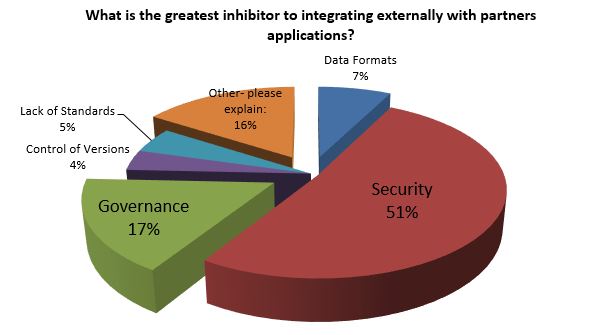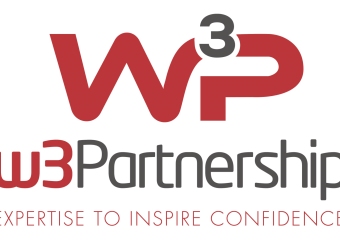Copyright
Copyright subsists in all W3Partnership publications. Except as permitted by Copyright Law, no extract may be reproduced, stored in a retrieval system or transmitted in any form or by any means – electronic, photocopying, recording or otherwise – without the prior permission in writing from W3Partnership.
© W3Partnership Limited (2016)
Contact Address:
W3Partnership Limited
18A Kendale
Hemel Hempstead
Hertfordshire, HP3 8NN
Tel: +44 (0) 845 8685041
All terms that are mentioned in this paper that are known to be trademarks or service marks have been appropriately capitalised. W3Partnership Limited cannot attest to the accuracy of this information. Use of a term in this document should not be regarded as affecting the validity of any trademark or service mark.
Table of Contents
Huge opportunity for reform.. 4
It’s legacy Captain, but not as we know it. 5
How open source is Open Source?. 7
In the ever more complex world of digital solutions, the ability to ensure the reliable delivery of information between source and destination(s) is critical.
Government organisations large or small are being challenged to deliver more through digital mediums, on an ever diminishing budget. These opposing dynamics are driving IT leaders and their staff to look at innovative solutions to meet these challenges. Their chosen solutions will all need some form of Integration to provide the optimum information to the consumer, in the optimum time, in a secure and safe way.
The two leading movements to meet these challenges is the adoption of “Open Source Software (OSS)”, in preference to commercially off the shelf software (COTS), together with the adoption of Cloud-based hosted platforms.
These movements have required a trust relationship to develop, where the belief that the power of “the many” can provide the answers to complex problems. It has required a trust that the commercial providers of OSS can deliver enterprise-ready support to their user community, at least equivalent to the COTS providers, whilst staying true to the principle of Open Source – i.e. providing enhancements and new features, available to all.
It also requires trust that Cloud solutions can provide a level of security, that isn’t going to compromise the users and expose their data to unwanted scrutiny.
There remains a large amount of confusion about what does and does not constitute Open Source software. Add to this the need to provide a reliable platform to deliver the many integration needs of complex IT systems, buyers and their technical staff are understandably confused about the market that exists and the choices that are available to the government sector.
In our survey, we seek to recognise the government communities understanding in relation to W3Partnerships’ specialisation which is “the delivery of solutions around service and application integration”.
We often describe ourselves as sophisticated software plumbers. Our job is to ensure that information moves, safely and reliably, between the initiator and the parties that require that information and back again; arriving translated and transformed, in an appropriate time and format for all parties.
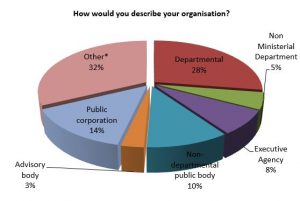
We carried out the survey via WiredGov – the leading online news service for government organisations. We received 211 completed responses in the survey. Respondents came from the following sectors.
*The other sector can further be broken down as 7% of respondents from Local Authorities and 6.5% from Academic institutes.
Although 67% said that they did have a strategy or were working on it, a surprising 32.8% responded that their organisation had no defined policy for digital by default.
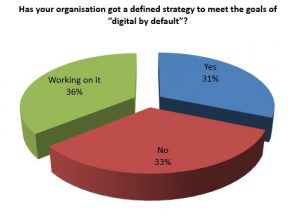
This represents a huge opportunity for savings within the government sector by introducing streamlined services either via self-service for the consumer or enhancing the provisioning of capacity and services within government department and agencies.
It’s legacy Captain, but not as we know it
Here we see that only 2.4% of those questioned believed that their organisation had stand-alone digital services; the majority are still operating with legacy system implementations in one form or another.
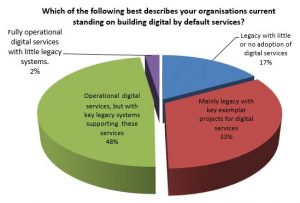
In reality, these legacy systems are often difficult to maintain because the technology is obsolete. The people who built these systems are nearing retirement age and the skills have not been passed on to a new generation. The net result is that the organisations that can support legacy solutions are in a near monopoly situation, where they can begin to charge what they like to support the systems.
However, Government buyers are not always aware of the hidden costs of supporting legacy systems. This is further compounded by scoring systems that are biased towards the value of systems improvements to end users, which does not recognise the hidden cost of maintaining these outmoded ways of working.
In one of his many ramblings, Gregor Hohpe (Hope, 2015), Chief Architect at Allianz SE, one of the world’s largest insurance companies, talks about adding planned obsolescence into any list of requirements when buying new software.
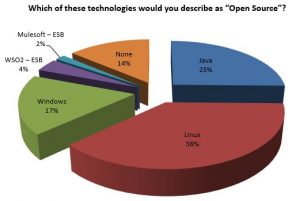
The idea that at the outset you should be planning how to exit from your newly purchased system ensures that you are not unconsciously buying into vendor lock-in with the subsequent cost of having to maintain outdated and outmoded systems because a data format or version of JDK is no longer supported.
“Open Source solutions” to be truly worthy of the name should have at their heart the notion that vendor lock-in is unacceptable in today’s modern IT systems. A good Open Source solution will have this principle not only at its core but throughout its DNA. Open standards that can, in theory, be supported by multiple vendors.
Government buyers should be wary of solutions that badge themselves as Open Source, but only apply the Open Source element to a basic function version of the product. These solutions lock buyers into their product set with highly proprietary add-ons to the product. Technical evaluators of any solution should always be asking themselves, what percentage of this product is Open Source and what percentage is proprietary?
How open source is Open Source?
With that in mind it is important for buyers of Integration solutions to recognise what is a truly open source solution and which are solutions that might contribute to Open Source or Open Standards bodies, but in fact provide highly proprietary products that will lead to vendor lock-in. All vendors mentioned in this question contribute to Open Standards bodies. But only a few could actually be described as delivering truly Open Source solutions consistently.
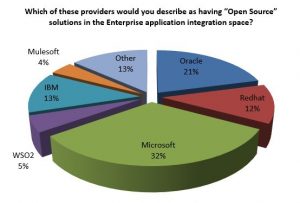
The increasing relevance of cloud computing services such as Software as a Service (SaaS) or Platform as a Service (PaaS) provides Digital leaders with a great opportunity to build a stronger business case for Service Oriented Architecture to their buyers. In his report, Saurabh Sharma (Ovum, 2012) explored the relevance of Service based architectures saying “….This is particularly applicable to organisations that had to abandon their SOA projects due to a lack of commitment from the business side. IT leaders of such organisations should emphasise that SOA-based integration with …….web services are options for SaaS integration requirements.”

However, there is a real problem in trying to prove the business case for adopting SOA. An often considered approach for organisations that have not yet implemented SOA, is to consider a lightweight option, such as one-off ”extract, translate and load” task that needs to be undertaken when uploading customer data from a system like SAP to Salesforce.com.
This provides a simple means to get more out of your SaaS-related investments. The danger is that Digital leaders and their buyers have to understand that lightweight implementations providing specific functionalities are only “good enough” for short-term integration requirements and are likely to lead to increased cost in the future. Gain today, pain tomorrow.
Often the best way to build the case is to develop a strategy of proving incremental gains, using lower cost but functionally rich “Open Source” solutions from organisations such as WSO2 or Mulesoft. These solutions have the benefit of proving the case for a SOA or REST based architecture without a large upfront investment. For further detailed analysis, look at the quantitative work of David. A. Wheeler (David.A.Wheeler, 2015)
An approach that starts from a Service Oriented Architecture and Patterns based mindset to building solutions should always be the starting point to avoid future hidden costs.
In their report, 451 Research described Hybrid Cloud integration platforms (451 Research, 2013). Their blueprint outlines and details the goals, policies, practices, techniques and tools needed to bring synergy between on-premise, virtualised, and cloud resources, so they operate and adapt as a uniform platform for business operations. In short, Hybrid Cloud Integration architecture is the ability to be able to control the various forms of Integration that exist in a single unified view.
The most often quoted inhibitor to building an integration platform in the cloud or sharing your data or importing 3rd party data into your systems, is the issue of security.
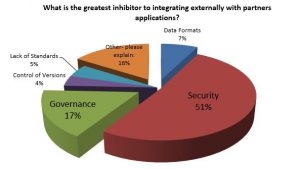
This is borne out by results of our survey. Those organisations that have done the least to adopt Cloud Integration solutions or take the opportunity to enhance their services to their consumers usually cite security as the number one concern, followed by cost.
Yet examples of large organisations who have adopted this approach and that have security at the centre of their thinking, abound. In their 6th annual report on Cloud computing Rightscale (Rightscale, 2016) showed that 71% of the 1,000 users surveyed had a Hybrid cloud strategy in place and that security was no longer the number one concern.
In the report, RightScale uses its Cloud Maturity Model to segment and analyse organisations based on their levels of cloud adoption. The Cloud Maturity Model identifies four distinct stages of cloud maturity. Denoting cloud adoption by organisations from least to greatest experience, the four stages are:
Cloud Watchers are organisations that are developing cloud strategies and plans but have not yet deployed applications into the cloud. Cloud Watchers want to evaluate available cloud options and determine which applications to implement in the cloud.
Cloud Beginners are new to cloud computing and are working on proof-of-concepts or initial cloud projects. Cloud Beginners want to gain experience with cloud in order to determine future projects.
Cloud Explorers have multiple projects or applications already deployed in the cloud. Cloud Explorers are focused on improving and expanding their use of cloud resources.
Cloud Focused businesses are heavily using cloud infrastructure and are looking to optimise cloud operations as well as cloud costs.
The survey, on which the RightScale 2016 “State of the Cloud” report is based, includes organisations across all the stages of cloud maturity.
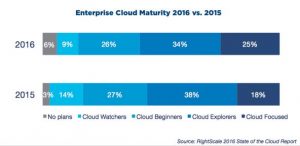
The same survey looked at the top 5 challenges for the various category of maturity. It is interesting to note how low security comes, with those organisations considered Cloud Focused.
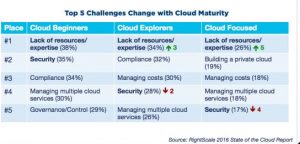
Government Digital leaders, whilst being challenged with the need to offer wider Digital Services with reduced budgets, must look upon this challenge as a real opportunity to innovate within an organisation.
It provides the opportunity to remove the expense of obsolete systems. The possibility of opening up new data sources to an organisation to provide better insight for local and national communities and the chance to try new working practises through Cloud adoption.
Buyers must understand that IT solutions are not just made up of end solutions that perform a single or range of functions, but multiple solutions and services that will always need to share data with other solutions and services. Therefore, Integration Platforms, which in themselves do not provide any obvious business value, must be a key part of their thinking, in order to avoid future costs and vendor lock-in.
It is important to understand the difference between truly Open Source solutions and vendors offering Open Source versions of their products which still leading to Vendor lock-in via proprietary add-ons.
The concern about security, whilst always a priority within an organisation, should not act as an inhibitor to innovation and should not stop technical evaluators and buyers realistically taking a hybrid approach to how they run and manage their infrastructure.
Last but not least. Always consider a pattern-based approach to development and maintenance of your integration landscape, where a consistent integration codebase can be re-used to instantiate new services. That way you will reduce costs and avoid lock-in via poorly engineered solutions.
451 Research. (2013, January 24). Hybrid Cloud Integration. Retrieved Feb 13, 2016, from 451 Research: http://img.en25.com/Web/ParAccel/%7B0e6a3cae-d84e-4689-938b-ad470397c943%7D_451_Research_Hybrid_cloud_integration-_Why_it’s_different_how_it’s_done_and_vendo.pdf
David.A.Wheeler. (2015, July 18). Why Open Source Software / Free Software (OSS/FS, FLOSS, or FOSS)? Look at the Numbers! Retrieved February 18, 2016, from dhwheeler.com: http://www.dwheeler.com/oss_fs_why.html
Hope, G. (2015, September 27). Ramblings. Retrieved Feb 12, 2016, from Enterprise Integration Patterns: http://www.enterpriseintegrationpatterns.com/ramblings/89_zombies.html
Ovum. (2012, June 12). exploring different approaches to SaaS integration. Retrieved Feb 15, 2016, from Ovum.com: http://www.ovum.com/research/exploring-different-approaches-to-saas-integration/
Rightscale. (2016, February 9th). Cloud Computing Trends 2016 state of the cloud survey. Retrieved Feb 13, 2016, from Rightscale.com: http://www.rightscale.com/blog/cloud-industry-insights/cloud-computing-trends-2016-state-cloud-survey

